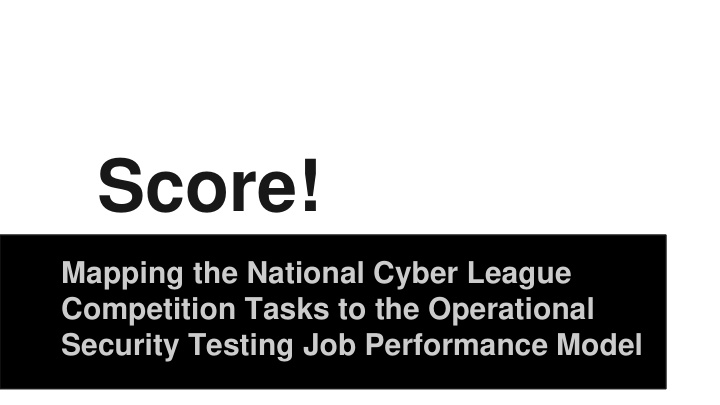



Score! Mapping the National Cyber League Competition Tasks to the Operational Security Testing Job Performance Model
Competitions What we know What we believe • • Encourages ethical practice and skill Increased knowledge of the work of cyber development in a controlled, legal professionals • environment Diverse competitions provide anytime- • Presents authentic circumstances where anywhere learning opportunities for students can apply theory and protocols individuals (from high school to college and skills learned in formal educational on to professionals and career changers) • environments Contributes to the knowledge-base of • Access to mentoring, resources, potential practitioners to resolve current issues, employers develop new tools, technologies, and • methodologies Access to scholarships, internships, and job • opportunities Contributes to curriculum and educator • capacity to meet employer, and national Opportunity to identify talent security needs
NCL Engagement Study Approach: Survey participants in the National Cyber League Fall pilot season competitions using the Utrecht Work Engagement (UWE 9) scale (Schaufeli et al., 2006) “Engagement is a positive, fulfilling, work-related state of mind that is characterized by vigor, dedication, and absorption.” • Source: Tobey, D., P. Pusey, D. Burley. March 2014. Engaging Learners in Cybersecurity Careers: Lessons from the launch of the National Cyber League. ACM Inroads: Special Section on Cybersecurity Education
Engagement - Experience Source: Tobey, D., P. Pusey, D. Burley. March 2014. Engaging Learners in Cybersecurity Careers: Lessons from the launch of the National Cyber League. ACM Inroads: Special Section on Cybersecurity Education
Novice Competitors over 3 Competitions 127 > 105 > 70 Source: Tobey, D., P. Pusey, D. Burley. March 2014. Engaging Learners in Cybersecurity Careers: Lessons from the launch of the National Cyber League. ACM Inroads: Special Section on Cybersecurity Education
NCL Study The NCL Education Committee in Collaboration with the CyberSecurity Competition Federation and the National CyberWatch Center are mapping the NCL competition structure (competition, graveyard and labs) to the NBISE Job Performance Model (Security Testing Model) to: • understand the types of skills the competition is involving • determine the extent to which there is a good overlap of coverage within the preparatory activities versus the competition • identify the most differentiating tasks within the job model • discover the competition tasks which have preparatory materials to support them
NCL Long Term Goals Long-term goals are to understand • how students skill development can be improved by current workforce development programs. • where we are vulnerable from a human level. (What attacks are most severe because we don't have the human capacity to address them.)
Job Performance Model • Enhance the development of the cybersecurity workforce • Provide a foundation for future certifications • Guide curriculum, assessments, and development of technical knowledge, skills and abilities • Identify the position of an individual along the progression through novice, beginner, proficient, competent, expert and master levels of expertise. Source: Tobey, D. H., Reiter-Palmon, R., & Callens, A. (2012). Predictive Performance Modeling: An innovative approach to defining critical competencies that distinguish levels of performance. OST Working Group Report. Idaho Falls, ID: National Board of Information Security Examiners.
Critical-Differentiation Matrix Fundamental and differentiating tasks that should best predict job performance • 83 tasks as fundamental • 20 indicators of the development of individual competence from novice to beginner, proficient, competition, expert, and master levels of expertise. Source: Tobey, D. H. (2011). A competency model of advanced threat response. ATR Working Group Report NBISE-ATR-11-02. Idaho Falls, ID: National Board of Information Security Examiners.
Critical-Differentiation Matrix
Intrusion Analyst SOURCE: O’Neil, L. R., Assante, M. J., & Tobey, D. H. (2012). Snart Grid Cybersecurity: Job Performance Model Report (Technical Report No. PNNL- 21639). Alexandria, VA: National Technical Information Service.
Intrusion Analyst SOURCE: O’Neil, L. R., Assante, M. J., & Tobey, D. H. (2012). Snart Grid Cybersecurity: Job Performance Model Report (Technical Report No. PNNL- 21639). Alexandria, VA: National Technical Information Service.
Intrusion Analyst SOURCE: Assante, M. J., Tobey, D. H., Conway, T. J., Leo, R., Januszewki, J., & Perman, K. (2013). Developing secure power systems professional competence: Alignment and gaps in workforce development programs *capability maturity model for energy systems. (Technical Report No. 2013-SGC-02). Idaho Falls, ID: National Board of Information Security Examiners.
Intrusion Analyst SOURCE: Assante, M. J., Tobey, D. H., Conway, T. J., Leo, R., Januszewki, J., & Perman, K. (2013). Developing secure power systems professional competence: Alignment and gaps in workforce development programs (Technical Report No. 2013-SGC-02). Idaho Falls, ID: National Board of Information Security Examiners.
Intrusion Analyst SOURCE: Assante, M. J., Tobey, D. H., Conway, T. J., Leo, R., Januszewki, J., & Perman, K. (2013). Developing secure power systems professional competence: Alignment and gaps in workforce development programs (Technical Report No. 2013-SGC-02). Idaho Falls, ID: National Board of Information Security Examiners.
Intrusion Analyst
Competition Design
Competition Design
Competition Design
Recommend
More recommend